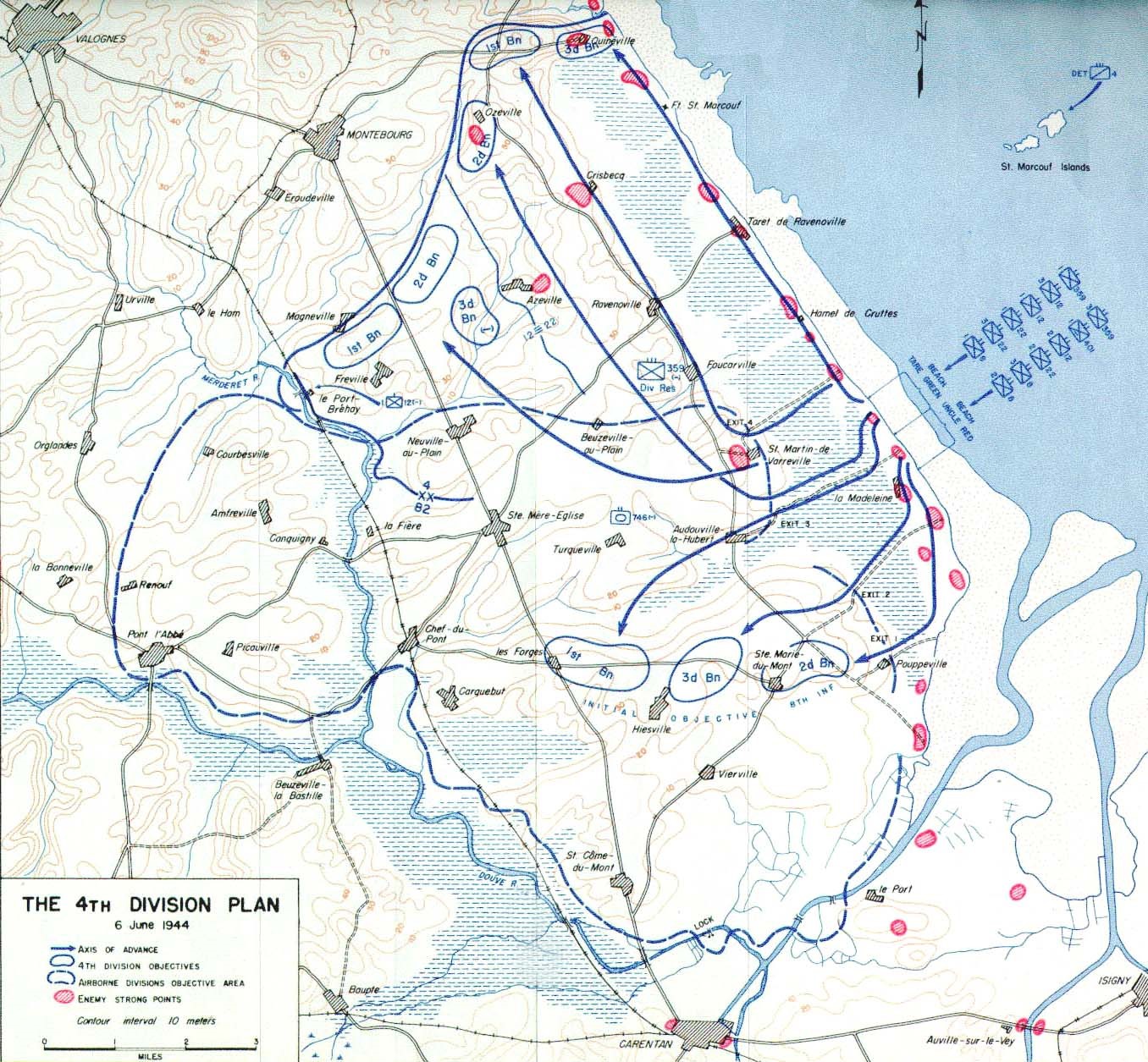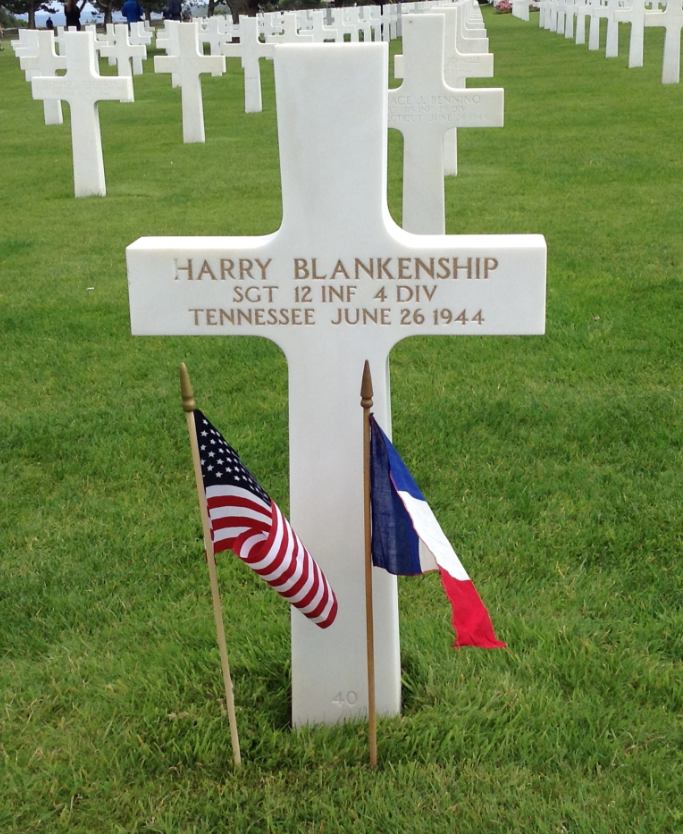Sergeant Harry Blankenship

- Unit: 4th Infantry Division, 12th Infantry Regiment, 3rd Battalion, Company I
- Service Number: 34186281
- Date of Birth: June 17, 1909
- Entered the Military: January 21, 1942
- Date of Death: June 26, 1944
- Hometown: Limestone, Tennessee
- Place of Death: France
- Award(s): Purple Heart, Silver Star
- Cemetery: Plot F, Row 14, Grave 40. Normandy American Cemetery, Coleville-Sur-Mer, France
Morristown-Hamblen High School West
2014-2015
Early Life
Harry Blankenship grew up in eastern Tennessee, the son of a farmer and the third child of eight children born to his mother, Minnie. After her death, his father, Cling, remarried and had four additional children, bringing the total to an even dozen — four boys and eight girls. Little is known of Harry’s early life.
Enlistment records reveal that Harry’s formal education ended in grammar school, which was not unusual in the 1920s. Growing up in a large farm family must have required every capable family member to contribute to the family unit.
Blankenship was drafted into the U.S. Army on January 21, 1942 at the age of 32. At the time of his enlistment, he was single with no children.
Military Experience
Prior to participating in D-Day, Blankenship had been in the Army over two years — at that time he would have been considered a seasoned veteran. (The average length of service during World War II was 33 months.)
Getting Ready for D-Day
Blankenship’s unit, I Company, 3rd Battalion, 12th Infantry Regiment, 4th Infantry Division, arrived in England on January 29, 1944 to train and prepare for D-Day. In April, the 4th Infantry Division would take part in its final training exercise, Operation Tiger. On May 18, the division moved to its designated marshalling area for final D-Day preparations.
On June 1, the men of the 4th Infantry Division began loading assault crafts that would soon be bound for Normandy, France. Blankenship and his unit spent the next five days waiting in ports in the United Kingdom. Little did they know that the operation they were about to participate in would become the most famous European battle of World War II for the United States.
Bound for the Beach
The 12th Infantry Regimental report paints a vivid picture of the unit’s journey to the beach on that fateful day of June 18, 1944:
Two miles away lay the irregular coastline of France. Morning clouded D-Day brooded over the choppy waters of the English Channel. The waiting infantry heard the first sounds of invasion bursting on the distant peninsula. The Infantry waited on board countless numbers of gray, gun bristling craft. British and American destroyers, cruisers, and battleships gave the appearance of a huge boating party. Zebra striped friendly planes flew back and forth above the great liberation regatta.Bits of wreckage drifted by the waiting boats. The Navy guns could be seen and heard spewing flame and smoke at the murky beach. Gray barrage balloons attached to low slung LCI’s blossomed from even beyond the dawn-streaked horizon.The attack signal was given. On June 6 at 1130 the first assault waves of the 12th Inf clambered down the sides of the LCI’s [stands for landing craft, infantry which is a landing craft designed to carry large numbers of infantrymen onto beaches] into smaller LCM’s [stands for landing craft, mechanized which is a landing craft designed to carry vehicles.] Riflemen, machine gunners, mortar men made last adjustments on their equipment. They grinned nervously at one another. Their eyes seemed to say “This is it — at last.”
For Blankenship, embarking on the watercraft bound for Utah Beach would be the beginning of the last three weeks of his life.
D-Day
The division’s mission was to assault Utah Beach at 6:30 a.m. and move inland to seize Cherbourg, France. However, the 12th Infantry Regiment, Blankenship’s unit, would not set foot on the beach until 11:30 a.m.
Colonel “Red” Reeder led the 12th Infantry Regiment onto Utah Beach and ensured that the fighting men of the 12th Infantry Regiment established a six-and-a-half-mile beachhead before the sun set that first day. There would be no rest for Blankenship and the other men of the 3rd Infantry Battalion. Throughout the night they moved forward in support of the 1st Infantry Battalion for an attack inland at dawn in the vicinity east of Beuzeville-au-Plain, France.
Advancing towards Montebourg
Under heavy enemy machine gun fire and rainy skies, Blankenship and the 3rd Battalion continued to push forward on June 7.
With the 1st Infantry Battalion on the right, Blankenship and the 3rd Infantry Battalion on the left, and the 2nd Infantry Battalion in reserves, the fight continued. The battalions were given the order to take the high ground north of Montebourg, France. Attempting to capture the high ground came at a heavy cost to both battalions.
Throughout the next few days, Blankenship and his unit continued to encounter pockets of heavy resistance as they advanced towards Montebourg. Five days of continuous fighting followed. However, despite a loss of two-thirds of their unit, the men of the 12th Infantry Regiment continued to answer the call to attack. A regimental report provided an eerie description of the men in the unit:
They no longer dodged instinctively at the sound of the overhead shells. They no longer feared the chair-scraping sound of the German ‘Nebelwerfers’. ‘Screaming Mimi’s’ they laughingly called them. They avoided digging foxholes in the hedgerows for they knew that the BB ‘air bursts’ caused more casualties due to splintering of trees.
By the end of the day on June 16, Blankenship’s unit controlled Montebourg. For the first time since landing on Utah Beach, Blankenship, along with the entire division, took a well-deserved rest.
The Battle for Cherbourg
The second phase of the campaign kept Blankenship and his unit busy patrolling, advancing, and participating in small engagements with the enemy. At this point it was clear that the enemy was retreating, but to where and in what numbers was still a mystery.
Blankenship, along with the entire division, entered the vicinity of Cherbourg. The battle for Cherbourg was a bitter struggle. It was the last remaining German fortification on the Cotentin Peninsula, and the Germans were not going to give it up without a fight.
By June 26, Cherbourg was firmly in the hands of the 4th Infantry Division. It is most likely during the heavy fighting of June 25 that Sergeant Blankenship received his fatal injuries. On his burial report, his injuries are listed as shrapnel to the right leg, hip severed. The official date of death was June 26, 1944.
From June 6 to June 28, the 4th Infantry Division sustained 5,414 casualties—997 killed in action, 129 died of wounds, 326 missing in action, 3,260 seriously wounded, and 702 slightly wounded. Every mile of ground gained was acquired with the blood, sweat, and tears of the men of the 4th Infantry Division.

Eulogy
Blankenship was originally buried in the temporary American military cemetery in St. Mère-Église, France. In 1948, Sergeant Blankenship’s brother, Earl, made the decision to have his remains disinterred from the St. Mère-Église and interred at the new Normandy American Cemetery. The cemetery is fittingly located near a bluff overlooking Omaha Beach.
The inscription at the memorial in the Normandy American Cemetery eloquently captures the enormity of the historic battle on D-Day and the incredibly brave men who paid the ultimate price for freedom fighting in that battle:
This embattled shore, portal of freedom, is forever hallowed by the ideals, the valor and the sacrifices of our fellow countrymen.

Reflection
Bibliography
4th Infantry Division; Records of the Adjutant General’s Office, World War II Combat Operations Report 1941-1948, Record Group 407 (Box 5663); National Archives at College Park, College Park, MD.
4th Infantry Division; Records of the Adjutant General’s Office, World War II Operations Reports,
1940-48, Record Group 407 (Box 5863); National Archives at College Park, College Park, MD.
4th Infantry Division; Records of the Adjutant General’s Office, World War II Operations Reports,
1940-48, Record Group 407 (Box 5867); National Archives at College Park, College Park, MD.
Combat Interviews, June 18, 1944; Records of the Adjutant General’s Office, World War II Combat Operations Report 1941-1948, Record Group 407 (Box 19029); National Archives at College Park, College Park, MD.
Descendants of Jasper Blankenship. Courtesy of James W. Blankenship.
Department of the Army Historical Division. 4th Division Plan, 6 June 1944. Washington, D.C.: U.S. Government Printing Office, 1947. www.history.army.mil/books/wwii/utah/maps/Map37.jpg.
Department of the Army Historical Division. The Final Drive on Cherbourg, 22-26 June 1944. Washington, D.C.: U.S. Government Printing Office, 1947. www.history.army.mil/books/wwii/utah/maps/Map28.jpg.
“Harry Blankenship.” American Battle Monuments Commission. Accessed October 8, 2014. www.abmc.gov/search-abmc-burials-and-memorializations/detail/WWII_60965#.VcY0fmzbKpo.
Harry Blankenship, Individual Deceased Personnel File, Department of the Army.
Harry Blankenship, Official Military Personnel File, Department of the Army, Records of the Army Staff, RG 319, National Archives and Records Administration – St. Louis
Records for Harry Blankenship; World War II Army Enlistment Records, 1938-1946 [Electronic File], Record Group 64; National Archives at College Park, College Park, MD [retrieved from the Access to Archival Databases at aad.archives.gov/aad/series-description.jsp?s=3360&cat=WR26&bc=,sl, December 1, 2014].
Tennessee. Green County. 1930 U.S. census. Digital images. ancestry.com.
This profile was researched and created with the Understanding Sacrifice program, sponsored by the American Battle Monuments Commission.

